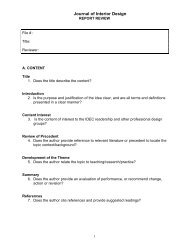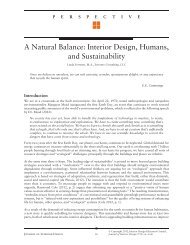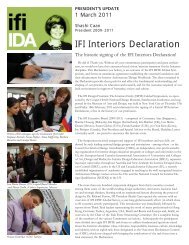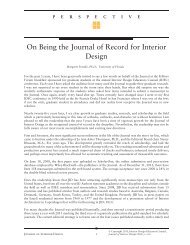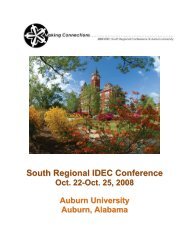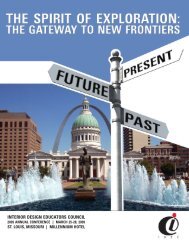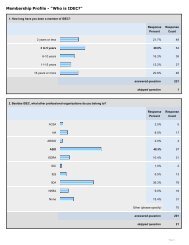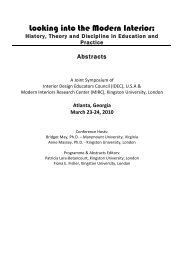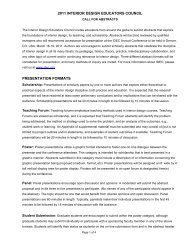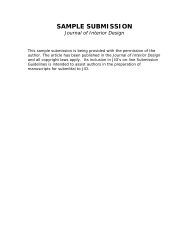A CONFLUENCE OF LIFESTYLE RETAILING, SUSTAINABLEDESIGN, AND HISTORIC PRESERVATION AT REI DENVER: AMODEL OF THE PROCESSPaper byKaren Hyllegard, Jennifer Paff Ogle, and Brian DunbarColorado State UniversityPurposeRecreation Equipment, Inc. (REI)—a Seattle-based, customer-owned cooperative thatsells outdoor equipment—has demonstrated sustained dedication to responsibleresource use and environmental stewardship since its founding in 1938. The relocationof REI’s Denver flagship store to the historic Denver Tramway Power Company Buildingaffords an opportunity to examine one business’ efforts to achieve profitability andsustainability in retail design and how these efforts were shaped by the motives ofdiverse stakeholders. The purpose of this study was to construct a taxonomy thatsummarizes diverse stakeholders’ logic and to develop a grounded theory model of thestakeholders’ decision-making processes with practical applications to teaching,research, and business. The objectives were to identify the philosophies, practices,knowledge, and goals of the stakeholders and to examine the interactions andnegotiation processes among them. The study was guided by frameworks of decisionmakingrelated to the selection, design, and use of commercial space (e.g., Durvasula,Sharma, & Andrews, 1992; Guy, 2000; National Park Service, 2001).MethodIn-depth, qualitative interviews were conducted with stakeholders who represented partof REI’s solution, including: REI Management, the building’s seller, the Denver City<strong>Council</strong>, the Denver Urban Renewal Association, the Colorado Historic Society, theNational Registrar of Historic Places, project architects, interior designers, and builders.Interview questions focused upon stakeholders’ (a) role in the project, (b) goal forinvolvement, (c) key decision-making factors, (d) core values, (e) work environment andstyle, (f) expertise and experiences, (g) units of assessment, and (h) benefits to ownorganization and/or general public. Interview data were analyzed using grounded theoryprocesses (Strauss & Corbin, 1990).42
Summary of ResultsThe taxonomy and grounded theory model generated from the analyses of interviewdata provide insights into the varied factors that contributed to REI’s decision toimplement principles of sustainable building design and historic preservation in therelocation of their Denver flagship store. The taxonomy presents the logic of eachstakeholder involved in the REI project. The grounded theory model illustrates threeorienting philosophies—retailing, sustainability, and preservation—that underpinned thedecision-making processes of the diverse stakeholders as well as the juxtaposition ofthese philosophies to arrive at a collaborative and amenable building solution. Elementsof this solution include efforts to• establish a store location with additional square footage and excellentvisibility,• retain original building materials and structures (e.g., windows, brickwalls, coal-fired power generator),• adaptively re-use structural beams reclaimed from a Montana mine,• construct energy-conserving building systems (e.g., natural lighting,HVAC), and• construct resource-conserving building facilities (e.g., undergroundparking structure that is earth-covered and planted with native, lowmaintenancevegetation; employee locker rooms with showers toencourage the use of bicycle commuting).Although the taxonomy and model were developed to represent one firm’s decisionmakingin its efforts to create an environmentally-sound retail space, both could beuseful as teaching tools that underscore the importance of understanding the variedlogics of stakeholders and the types of negotiation necessary to arrive at a designsolution that is workable for those involved. Similarly, the taxonomy and model canserve as useful frameworks for future research exploring such decision-makingprocesses.ReferencesDurvasula, S., Sharma, S., & Andrews, J. C. (1992). STORELOC: A retail storelocation model based on managerial decisions. Journal of Retailing, 68(4), 420-444.Guy, S. (2000). Framing environmental choices: Mediating the environment in theproperty business. In S. Fineman (Ed.), The business of greening (pp. 54-77).New York: Routledge.National Park Service. (2001, September 21, 2001). The secretary of the interior’sstandards for the treatment of historic properties. Retrieved September 26, 2001from http://www2.cr.nps.gov/tps/standguide/index.htmStrauss, A., & Corbin, J. (1990). Basics of qualitative research: Grounded theoryprocedures and techniques. Newbury Park, CA: Sage.43
- Page 1 and 2: Interior Design Educators CouncilIN
- Page 7 and 8: PAPERS7
- Page 9: Summary Of ResultsThe exploratory d
- Page 12 and 13: AFFECTING INFANT OUTCOMES BY DESIGN
- Page 14 and 15: PREFERRED PLACEMENT AND REPETITION
- Page 16 and 17: ATTITUDES OF HIGHER EDUCATION INTER
- Page 18 and 19: A THEORETICAL FRAMEWORK FOR SUDTAIN
- Page 20 and 21: PERCEPTION OF OPPORTUNITY FOR INNOV
- Page 22 and 23: JACK LENOR LARSEN AND HIS SIGNIFICA
- Page 24 and 25: PROBLEM SOLVING IN THE INSTITUTIONA
- Page 26 and 27: MATERIAL SELECTION IN INTERIOR DESI
- Page 28 and 29: THE EVERETT L. MARSHALL BUILDING AT
- Page 30 and 31: THE IMPACT OF PERIODICALS ON THE PE
- Page 32 and 33: USE OF VIRTUAL ENVIRONMENTS TO EXPL
- Page 34 and 35: NEW WAYS OF TEACHING AND LEARNING T
- Page 36 and 37: Shaw, G., Brown, R., & Bromiley, P.
- Page 38 and 39: Participants discussed supplemental
- Page 40 and 41: The effects of physical environment
- Page 44 and 45: A COMPARISON OF REGIONAL AND NATION
- Page 46 and 47: EFFECTS OF GROUP INTERACTIVE BRAINS
- Page 48 and 49: ReferencesBarnard, S. S. (1992). In
- Page 50 and 51: Summary of ResultsEvidence is provi
- Page 52 and 53: FENG SHUI AND EBS: A CONVERGENCE OF
- Page 54 and 55: UTILIZING THE EDEN ALTERNATIVE IN D
- Page 56 and 57: INTERIOR DESIGN—AN EXCITING CAREE
- Page 58 and 59: TRANSFORMATIONAL LEARNING: AN INTER
- Page 60 and 61: CHANGING ECOLOGY OF THE DESIGN STUD
- Page 62 and 63: TWO’S COMPANY, THREE’S A GOOD D
- Page 64 and 65: TEACHING UNIVERSAL DESIGN THROUGH C
- Page 66 and 67: "DESIGNING DOMESTICITY":BRINGING LI
- Page 68 and 69: SHADES OF GREEN: THE PHILOSOPHICAL
- Page 70 and 71: CAN WE TEACH STUDENTS TO THINK CRIT
- Page 72 and 73: DEVELOPING A SPATIAL MODEL FOR MODE
- Page 74 and 75: Seo, Hae Yang (2001), Factors Influ
- Page 76 and 77: BLUEBONNET SWAMP LEARNING COMMUNITY
- Page 78 and 79: VIRTUAL EXHIBITIONS: A NEW DIMENSIO
- Page 80 and 81: FIELDWORK FOR UNIVERSAL DESIGN PROB
- Page 82 and 83: VIRTUAL INTERNSHIPS:UNRAVELING THE
- Page 84 and 85: FORGOTTEN LESSONS: PRIMITIVE CULTUR
- Page 86 and 87: THE VOID BETWEEN SUSTAINABILITY AND
- Page 88 and 89: INTEGRATING 3-D MODELING AND HISTOR
- Page 90 and 91: POSTERS90
- Page 92 and 93:
Phase Three. The third phase moves
- Page 94 and 95:
The modification suggested by this
- Page 96 and 97:
SummaryUnique features of the model
- Page 98 and 99:
ON THE EDGE OF ADVANCEMENT: SOLVING
- Page 100 and 101:
Those in attendance at the event co
- Page 102 and 103:
SYMBOLS OF SELF: REPRESENTATIVE OBJ
- Page 104 and 105:
DIGITAL MONTAGE: A HYBRID MODEL FOR
- Page 106 and 107:
MAINTAINING ORDER: VETRUVIUS AND PA
- Page 108 and 109:
FREEDOM AND CONSTRAINT IN THE DESIG
- Page 110 and 111:
BUILDING COMMUNITY: INTERIOR DESIGN
- Page 112 and 113:
UNDERGRADUATE COLLABORATIVE RESEARC
- Page 114 and 115:
ENHANCING AWARENESS OF HOW WE SPEND
- Page 116 and 117:
SUSTAINABLITY THROUGH DIVERSITY AND
- Page 118 and 119:
PRESERVING THE ENNIS-BROWN HOUSE AN
- Page 120 and 121:
ReferencesBaines, J., & Málek, J.
- Page 122 and 123:
The research team selected the LEED
- Page 124 and 125:
Fourteen programs have been conduct
- Page 126 and 127:
OutcomesThere was, of course, uncer
- Page 128 and 129:
Summary of ResultsIntegrating an ed
- Page 130:
• How to work with software vendo





